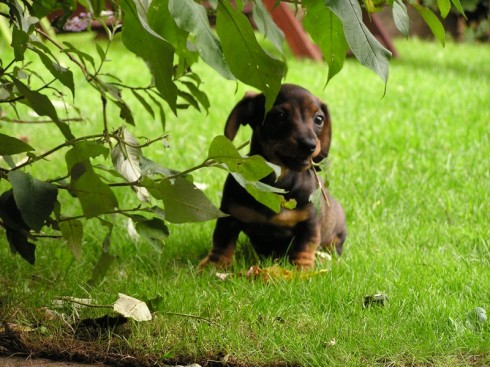- Opening the books on a Dachshund’s intelligence
- Accepting that Dachshunds don’t speak English
- Talking to and understanding the Dachshund
- Relating to your individual Dachshund
You’ve heard it from this book (if you’ve read earlier chapters) and probably from many other places if you’ve been doing your Dachsie research: Dachshunds are notoriously stubborn. You may also have heard the words defiant, willful, obstinate, headstrong, and intractable. All true, yes, and appropriate in some Dachshunds more than in others.
Looking for Signs of Intelligent Life
– The kind of intelligence that makes a dog highly and easily trainable (Border Collies, Shelties, and Labrador Retrievers are this kind of intelligent, for example)
– The kind of intelligence that manifests itself as the ability to think without requiring direction from humans
Remember
Most dogs want to please the people they love, but not to the point of severe boredom through senseless repetition or through the performance of an activity that doesn’t seem to have a point. Dachshunds revel in fun, but what’s so fun about standing in the middle of the living room floor, being told to sit, stand, sit, stand, sit, stand, sit, stand? Keep your training sessions short, frequent, fun, and challenging. If you’re bored, your Dachshund is probably bored, too. (For more training tips, head to Chapter Taking Charge of Your Dachsie and keep going.)
– They want to be with you.
– They want something interesting to do with their time.
– They want to enjoy their food, their sleep, and their playtime.
– They want to learn tricks and do what you ask, as long as it makes sense to their doggy minds.
Why Dachshunds Are Independent Thinkers
Field trials: Independent thinking in actionWatching a Dachshund field trial is a great way to observe the Dachshund’s independent nature in action. In Dachshund field trials, Dachshunds compete in pairs to follow the scent of a rabbit. (The rabbit isn’t caught or killed; usually, it isn’t even seen by the dogs.) When the dogs catch the scent, or line, of the rabbit, the handlers aren’t allowed to intervene in any way to direct the Dachshunds. The dogs must trail the scent all on their own, followed by the watchful judges who determine which Dachshunds are most capable of following the trail. See Chapter Advanced Training and Competing for Fun for more on these field trials. |
Dachshunds Can’t Obey What They Don’t Understand
Warning!
Never hold a grudge against your Dachshund. After a few seconds, your dog will have no idea what you’re angry about. Dogs live in the present, and they only know that you’re angry. If you decide to punish your pup for chewing your shoe by keeping her locked up for two hours or by ignoring her all day, your punishment will be ineffective and even destructive, because your Dachshund will learn to fear you or avoid you rather than listen to you.
Communicating with Your Dachshund
Tip
To get through to this uneducated and independent-minded little Dachshund, you have to be very specific in your rewards. The moment she does something good, praise her, pet her, even give her the occasional treat. When she’s naughty, redirect her to the right activity (hand her a chew toy, move her to her outdoor bathroom, and so on) without making any fuss. Ignore her until she does the right thing again and then heap on the praise. Now she’ll get the message.
Remember
Don’t just praise your dog when she does something you ask her to. Also praise her when she does something well or right when you didn’t ask. Constant positive reinforcement of good behavior is integral to developing a good relationship with your Dachshund. If you spend the whole day yelling “No!” and “Bad dog!” but never rewarding your Dachshund for the things she does right, she won’t learn the self-confidence that’s so important to a well-trained and happy pet. And she certainly won’t learn what you want her to.
Accentuating the positive
– Positive reinforcement rewards desired behavior with something the dog wants, such as a treat or praise.
– Negative reinforcement rewards desired behavior by removing an unpleasant condition — like when you release a choke chain after your dog sits.
– Punishment discourages undesired behavior by inflicting something undesirable, such as a scolding.
– Extinction doesn’t reinforce undesired behavior — like when you ignore your Dachshund when she jumps up on you.
Tip
Positive reinforcement used in conjunction with extinction is considered by many contemporary trainers to be the most effective, fast, and humane method of dog training. When your Dachshund does something you want her to do, reward her immediately and heap on the praise. When she does something she isn’t supposed to do, don’t reinforce the behavior. Completely ignore her. She’ll hate that.
Of course, if she’s doing something dangerous or damaging, you have to stop her immediately. Whisk her outside before she eliminates on your carpet or remove her jaws from your table leg. Accompany your removal with a firm “No!” But don’t make a big deal about it. She won’t understand, she’ll get scared, and even if she does learn not to chew the table in your presence (because that’s the only time she gets punished for it), she won’t understand that she shouldn’t ever chew on the table.
Remember
One of the most important things to remember when communicating with your Dachshund is consistency. If you praise your Dachshund for obeying your command one day and then ignore her for obeying your command the next day, she won’t get it. If you refuse to let her on your bed one day and then let her on your bed the next day, she won’t get that, either. Make the rules and stick to them. If you must change them, keep them changed. Dachshunds don’t understand waffling.
Staying calm and upbeat
Remember
If you want to relate to your Dachshund, the most important thing you can do is stay positive. Getting angry when your Dachshund eats your loveseat or leaves a puddle on your antique quilt is understandable, but it won’t do any good. Leave the room, get angry, get over it, come back, and resolve not to let it happen again, because (and you may not want to hear this) the whole thing was your fault anyway.
Showing, telling, and reinforcing
1. Taking your Dachshund to her elimination station every hour or so the first day you have her is showing her.
Rewarding your good dog with new treatsTired of the same old pieces of kibble for positive reinforcements? You can use many things to reward your Dachshund. Here are some ideas:
Some trainers don’t believe in using food rewards, but Dachshunds are highly foodmotivated, so as long as your rewards don’t cause your Dachshund to become overweight, using food rewards is a great way to train. |
2. Associating this action with a word or phrase, such as “Go potty,” is how showing leads to telling.
3. Praising her and/or offering her a bit of kibble when she does her duty is positive reinforcement.
Tip
The most effective method, in my opinion, for showing, telling, and reinforcing what’s expected of your Dachshund is lure-and-reward training. You use a lure, such as a piece of kibble or a treat, to guide your Dachshund into the desired position as you tell her the name of the position — Sit, Lie Down, Bow, or whatever. When she achieves the position, Dachsie gets the treat. Show, tell, and reinforce. Now that isn’t a difficult communication.
Recognizing “Normal” Dachshund Behavior
A common Dachshund mentality
– They enjoy pleasurable activities. They require food, water, sleep, and affection. They absolutely love to go on walks, play outdoors, chase squirrels, chase balls (but not necessarily give them back to you), sleep under the bedcovers with you, and curl up on your lap to watch television. They’ll do just about anything for your undivided attention.
– They don’t enjoy being hungry, in pain, overly tired, uncomfortable, or frightened, and they absolutely hate it when you’re displeased with them — especially if they don’t know why. They don’t want to be ignored. They want to be the center of your universe, and they sincerely believe they deserve to be.
– They don’t know what “Sit” means until you show them. But they’re smart, so after you show them, they’ll understand. They don’t know why you want them to do boring, repetitive things when they could be sniffing around or having lunch. But they’ll do those things if the reward is big enough. They want to know why they shouldn’t pull on the leash. So if you make it clear that pulling on the leash means no walk and that trotting politely by your side means a long walk, they’ll be happy to oblige.
Nature versus nurture
Warning!
Some dogs seem to be completely untrainable. Well into the first year, though, their owners suddenly discover that these dogs are deaf — an affliction that happens sometimes with Dachshunds, most often in dogs with large areas of white. There are alternate methods for training deaf Dachshunds, which you can learn from a professional trainer with experience in this area. The following section digs deeper into the topic of health problems.
When training problems mean health problems
– Never obeys your commands when she can’t see your face.
– Was housetrained but suddenly begins to have accidents inside the house regularly.
– Behaves aggressively for no good reason, especially if you’ve trained your Dachshund not to bite or if she has never exhibited aggressive behavior before.
– Suddenly becomes shy around people when she wasn’t previously.
– Suddenly seems forgetful or confused, possibly bumping into furniture (more common in older dogs).
– Suddenly refuses to come, go on a walk, or move at all.
– Yelps when touched.
– Suddenly becomes destructive, fearful, or hysterical when left alone.
The behaviorist is your ally
Tip
Don’t be shy about calling a behaviorist. Plenty of people do, and plenty of people are very glad they did. Many dogs have been saved through simple behavior-modification techniques. Most dogs surrendered to animal shelters are there because of behavioral problems their owners couldn’t or wouldn’t handle. Don’t let your Dachshund suffer this fate. Learn her language, train her, hire a professional when necessary, and immerse your dog in plenty of love. Now you’re talking Dachshund.
Technical Stuff
Some dog trainers also call themselves canine behavioral consultants. These trainers may not have advanced degrees in animal behavior like a behaviorist, but they may have a lot of practical experience with behavior problems. A consultant could be a big help when you’re trying to solve a training problem, depending on your situation, but behaviorists generally have more formal education. Only behaviorists can prescribe medication, such as a medicine that may be appropriate for separation anxiety or aggression.
– To find an animal behaviorist, check out the Animal Behavior Society’s public directory of certified animal behaviorists at www.animalbehavior.org/ABSAppliedBehavior/caab-directory.
– For a list of behavior consultants, check out the International Association of Animal Behavior Consultants (IAABC) at www.iaabc.org.
– For a list of trainers who specialize in behavior problems, check out the Association of Pet Dog Trainers’s site at www.apdt.com and click on Dog Trainer Search.
by Eve Adamson







